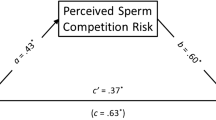Abstract
Men who spend a greater proportion of time apart from their female partner since the couple’s last copulation are at greater “objective” sperm competition risk. We propose a novel cue to sperm competition risk: the time she spends with her male friends. Four hundred and twenty men in a committed, heterosexual, sexual relationship completed a questionnaire. The results indicate that men at greater objective sperm competition risk report less time desired until the couple’s next copulation, greater interest in copulating with their partner, and greater anger, frustration, and upset in response to their partner’s sexual rejection, but only among men whose partner spends more time with her male friends. These results remain after controlling statistically for the participant’s age and their partner’s age. We discuss limitations of the current research, and discuss how research in human sperm competition can inform social issues, including men’s partner-directed sexual coercion.





Similar content being viewed by others
References
Aiken, L. S., & West, S. G. (1991). Multiple regression: Testing and interpreting interactions. Newbury Park: Sage.
Baker, R. R., & Bellis, M. A. (1993). Human sperm competition: ejaculate adjustment by males and the function of masturbation. Animal Behaviour, 46, 861–885.
Camilleri, J. A. (2004). Investigating sexual coercion in romantic relationships: A test of the cuckoldry risk hypothesis. (Unpublished master’s thesis). University of Saskatchewan, Saskatoon, Canada.
Camilleri, J. A., & Quinsey, V. L. (2009). Testing the cuckoldry risk hypothesis of partner sexual coercion in community and forensic samples. Evolutionary Psychology, 7, 164–178.
Finkelhor, D., & Yllo, K. (1985). License to rape: Sexual abuse of wives. New York: Holt, Rinehart, & Winston.
Frieze, I. H. (1983). Investigating the causes and consequences of marital rape. Signs, 8, 532–553.
Gage, A. J., & Hutchinson, P. L. (2006). Power, control, and intimate partner sexual violence in Haiti. Archives of Sexual Behavior, 35, 11–24.
Goetz, A. T., & Shackelford, T. K. (2006). Sexual coercion and forced in-pair copulation as sperm competition tactics in humans. Human Nature, 17, 265–282.
Goetz, A. T., & Shackelford, T. K. (2009). Sexual coercion in intimate relationships: a comparative analysis of the effects of women’s infidelity and men’s dominance and control. Archives of Sexual Behavior, 38, 26–234.
Goetz, A. T., Shackelford, T. K., & Camilleri, J. A. (2008). Proximate and ultimate explanations are required for a comprehensive understanding of partner rape. Aggression and Violent Behavior, 13, 119–123.
Hällström, T., & Samuelsson, S. (1990). Changes in women’s sexual desire in middle life: the longitudinal study of women in Gothenburg. Archives of Sexual Behavior, 19, 259–268.
Kaighobadi, F., Shackelford, T. K., Popp, D., Moyer, R. M., Bates, V. M., & Liddle, J. R. (2009). Perceived risk of female infidelity moderates the relationship between men’s personality and partner-directed violence. Journal of Research in Personality, 43, 1033–1039.
Lalumière, M. L., Harris, G. T., Quinsey, V. L., & Rice, M. E. (2005). The causes of rape: understanding individual differences in male propensity for sexual aggression. The Journal of Psychiatry and Law, 33, 419–426.
Lewis, R. W., Fugl-Meyer, K. S., Bosch, R., Fugl-Meyer, A. R., Laumann, E. O., Lizza, E., et al. (2004). Epidemiology/risk factors of sexual dysfunction. The Journal of Sexual Medicine, 1, 35–39.
McKibbin, W. F., Bates, V. M., Shackelford, T. K., LaMunyon, C. W., & Hafen, C. A. (2010). Risk of sperm competition moderates the relationship between men’s satisfaction with their partner and men’s interest in their partner’s copulatory orgasm. Personality and Individual Differences, 49, 961–966.
McKibbin, W. F., Starratt, V. G., Shackelford, T. K., & Goetz, A. T. (2011). Perceived risk of female infidelity moderates the relationship between objective risk of female infidelity and sexual coercion in humans (Homo sapiens). Journal of Comparative Psychology, 125, 370–373.
Parker, G. G. (1970). Sperm competition and its evolutionary consequences in the insects. Biological Review, 45, 525–567.
Russell, D. E. H. (1982). Rape in marriage. New York: Macmillan Press.
Shackelford, T. K., LeBlanc, G. J., Weekes-Shackelford, V. A., Bleske-Rechek, A. L., Euler, H. A., & Hoier, S. (2002). Psychological adaptation to human sperm competition. Evolution and Human Behavior, 23, 123–138.
Shackelford, T. K., Goetz, A. T., McKibbin, W. F., & Starratt, V. G. (2007). Absence makes the adaptations grow fonder: proportion of time apart from partner, male sexual psychology, and sperm competition in humans (Homo sapiens). Journal of Comparative Psychology, 121, 214–220.
Smith, R. L. (1984). Human sperm competition. In R. L. Smith (Ed.), Sperm competition and the evolution of animal mating systems (pp. 601–659). New York: Academic.
Starratt, V. G., Goetz, A. T., Shackelford, T. K., & Stewart-Williams, S. (2008). Men’s partner-directed insults and sexual coercion in intimate relationships. Journal of Family Violence, 23, 315–323.
Starratt, V. G., McKibbin, W. F., & Shackelford, T. K. (2013). Experimental manipulation of psychological mechanisms responsive to female infidelity. Personality and Individual Differences, 55, 59–62.
Author information
Authors and Affiliations
Corresponding author
Rights and permissions
About this article
Cite this article
Pham, M.N., Shackelford, T.K. The Relationship Between Objective Sperm Competition Risk and Men’s Copulatory Interest Is Moderated by Partner’s Time Spent with Other Men. Hum Nat 24, 476–485 (2013). https://doi.org/10.1007/s12110-013-9181-0
Published:
Issue Date:
DOI: https://doi.org/10.1007/s12110-013-9181-0




